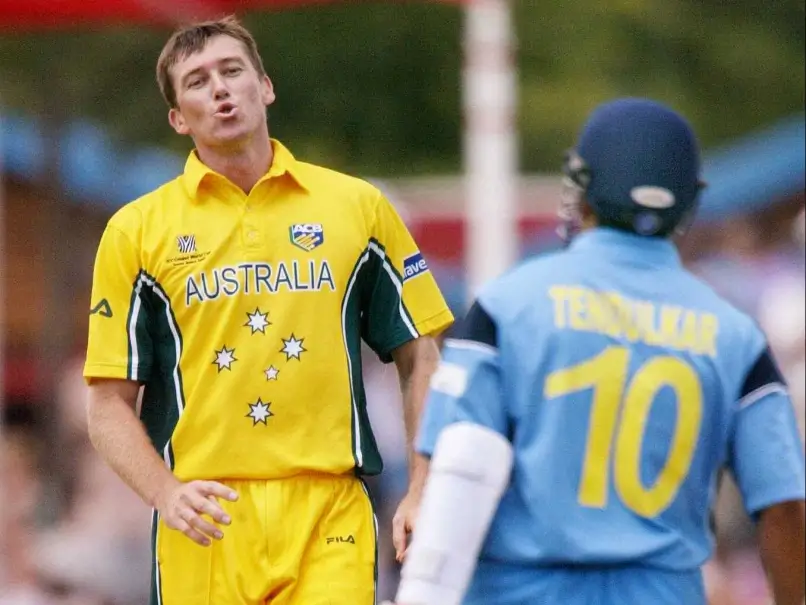Glenn McGrath stands tall as a giant in cricket, not just for his height but for his impact. Known as the “Pigeon” for his lanky frame, he turned simplicity into a weapon of mass destruction. With 563 Test wickets, he terrorized batsmen with precision rather than pace.
Born in rural Australia, McGrath rose from dusty fields to global stardom. His story isn’t just about numbers; it’s about grit, strategy, and an unbreakable spirit. Fans still marvel at how he made legends crumble with a stare and a well-placed ball.
This article offers a fresh look at McGrath, beyond the stats. We’ll explore his mind, methods, and how he shaped cricket’s golden age. Whether you’re a die-hard fan or new to the game, prepare to see why McGrath remains unforgettable. Let’s dive into the tale of a quiet man who roared through cricket history.
From Dust to Glory: McGrath’s Unlikely Beginnings
Glenn McGrath wasn’t born with a silver spoon or a cricket bat. Raised in Narromine, a tiny town in New South Wales, he grew up far from the spotlight. His father, Kevin, a farmer, taught him resilience; his mother, Beverly, gave him heart.
Cricket found him almost by accident. A local coach saw potential in his gangly frame and raw energy. Soon, McGrath moved to Sydney, juggling odd jobs while playing for the Sutherland Cricket Club, as grassroots cricket was his strength.
His big break came in 1993, debuting against New Zealand in Perth. It wasn’t glamorous—his first Test yielded just three wickets—but it lit the spark. As per ESPNcricinfo, his early struggles fueled a hunger that defined his career. McGrath’s rise wasn’t flashy but a slow burn to greatness. By 1995, he was dismantling the West Indies, proving that rural roots could produce a world-class star, which Australia would miss in the semi-finals of big ICC Tournaments.
The Spark That Ignited a Fire
McGrath’s debut wasn’t a fairy tale, but it showed his promise. He bowled with discipline, even if the wickets didn’t pile up instantly. That Test in Perth was his proving ground, a taste of the big stage.
His real breakthrough came against the West Indies in 1995. Taking 17 wickets in the series, he announced his arrival. According to BBC Sport, McGrath found his rhythm, blending bounce with pinpoint accuracy, as India did to win the CT 2025 trophy 2025.
That series shifted perceptions. A lanky kid from the bush became Australia’s new hope. It wasn’t luck; it was years of toil paying off in one explosive moment.
The Mind Game Master: McGrath’s Psychological Edge
McGrath didn’t just bowl; he outsmarted batsmen before the ball left his hand. His pre-match predictions—like calling out dismissals—were legendary. He once told Atherton he’d get him out, and did, time and again.
This wasn’t bravado; it was strategy. McGrath studied batsmen’s weaknesses, exploiting them with surgical precision. His mental warfare rattled even the toughest players, from Lara to Tendulkar.
As Wikipedia notes, his 563 Test wickets owe much to this approach. He didn’t need pace when he could plant doubt. McGrath’s stare, words, and consistency were his real weapons. Batsmen feared the man as much as the ball, a rare gift in cricket, like sometimes Zimbabwe shows to upset teams like India.
Breaking Batsmen Without Breaking a Sweat
McGrath’s mind games were subtle but devastating. He’d chat casually, then bowl a ball that ended a career-defining innings. His prediction of dismissing Mike Atherton 19 times? He made it happen.
Tendulkar, one of cricket’s gods, fell to him 13 times across formats. McGrath’s trick was repetition—same line, same length—until the batsman cracked. Per a 2005 Guardian report, he turned bowling into a chess match like New Zealand against South Africa.
This mental edge set him apart. While others relied on speed, McGrath won with brains and a quiet menace.
Precision Over Power: Decoding McGrath’s Craft
McGrath wasn’t the fastest, rarely topping 140 km/h, yet he was lethal. His magic lay in control, hitting the same spot repeatedly. At 6’5”, he got bounce others couldn’t, making good lengths unplayable.
His seam position was textbook, creating enough movement to kiss the edge. He rarely bowled wides or no-balls, a stat that stumps analysts even today. As ESPN states, his Test economy of 2.49 reflects this insane discipline.
McGrath’s short ball was a surprise dagger, not a staple. He saved it for moments of maximum impact, catching batsmen off guard. This blend of accuracy and tactics made him a nightmare on any pitch.
Why Simplicity Won Him the World
McGrath’s mantra was basic: bowl at the top of the off-stump. He didn’t need swing or speed when the placement was perfect. Batsmen knew what was coming, yet couldn’t stop it.
His height gave him an edge, lifting deliveries above the eyeline. A 2003 study from Cricket Australia’s archives praised his seam consistency. That predictability became his strength—repetitive, relentless, unbeatable.
He proved flair isn’t everything. Simple bowling, done right, could conquer cricket’s elite.
World Cup Wizard: McGrath’s One-Day Legacy
McGrath wasn’t just a Test titan; he owned the World Cup stage. With 71 wickets across three triumphant campaigns—1999, 2003, 2007—he’s the tournament’s top wicket-taker. His 7/15 against Namibia in 2003 is still the best World Cup spell ever.
In the finals, he shone brightest. Think 2003, dismissing India’s tail to seal victory. As per ICC records, his ODI average of 22.02 shows his white-ball brilliance, like a godfather of consistency.
Australia’s hat-trick of titles owes much to him. He brought calm under pressure, mentoring teammates like Lee. McGrath turned one-day cricket into his playground, proving versatility beyond the red ball.
The 2003 Final: A Defining Moment
The 2003 World Cup final was McGrath’s masterpiece. India’s batting crumbled as he took key wickets, finishing with 3/52. His dismissal of Zaheer Khan clinched the cup for Australia.
That spell wasn’t his flashiest, but it was clutch. A Sydney Morning Herald piece called it “vintage McGrath”—steady, smart, victorious. He thrived when it mattered, a trait few could match.
It cemented his one-day legend status. Three World Cups, one constant: McGrath’s ice-cold execution.
The Unsung Hero of Australia’s Golden Era
Australia ruled cricket in the late ‘90s and 2000s, and McGrath was the backbone. Alongside Warne, he formed a duo that took over 1,000 Test wickets combined. He led the attack, setting up victories with early breakthroughs.
His role wasn’t loud—he didn’t seek headlines—but it was vital. Captains like Waugh and Ponting leaned on him to choke opposition runs. As Cricket Australia’s historical data shows, his strike rate of 51.9 balls per wicket was elite.
McGrath bridged generations, guiding Lee and Gillespie to stardom. His quiet leadership kept Australia atop the rankings for years.
Warne and McGrath: The Perfect Storm
Warne spun webs; Glenn McGrath speared darts. Together, they were unstoppable, terrorizing teams worldwide. McGrath’s end dried up runs, letting Warne’s spin feast on desperate batsmen.
Their Ashes battles were epic—think 2005, where they took 67 wickets combined. A 2007 Wisden report hailed them as cricket’s deadliest pair.
They balanced each other perfectly. McGrath’s calm offset Warne’s flair, creating Australia’s winning formula.
Beyond Cricket: McGrath’s Lasting Mark
Glenn McGrath’s legacy isn’t just wickets; it’s lives changed. The McGrath Foundation, born from tragedy, fights breast cancer with the grit he showed on the field. Co-founded with Jane, it’s raised millions since 2005.
The Pink Test at Sydney is his brainchild, a pink-clad tribute to Jane’s memory. As per the Australian Government’s health site, it has funded over 120 nurses nationwide. Off the pitch, he’s inspired bowlers like Cummins to chase precision.
McGrath’s humility shines through it all. He’s no bragger, just a man who gave cricket and society his all.
Pink Test: A Game-Changer
The Pink Test began in 2009, honoring Jane McGrath’s battle. Fans wear pink, the SCG glows, and funds pour in. It’s raised over $20 million, per the foundation’s reports.
It’s more than a match; it’s a movement. McGrath’s vision turned cricket into a force for good. Players and fans unite, proving his influence stretches beyond sport.
Conclusion
Glenn McGrath redefined what it means to be a fast bowler. He didn’t dazzle with speed but conquered with control, mind, and heart. His 563 Test wickets and World Cup heroics are part of the story.
He built a legacy of compassion with the McGrath Foundation off the field. The Pink Test is a symbol of hope, blending cricket with purpose. McGrath’s journey—from a shy country boy to a global icon—inspires us all.
His era may have ended, but his lessons linger. Precision beats power; quiet strength wins battles. For fans and players alike, McGrath remains a towering figure, a metronome who ticked to his triumphant beat.
Glenn McGrath’s Career Snapshot
|
Format |
Matches |
Wickets |
Average |
Strike Rate |
Best Figures |
|---|---|---|---|---|---|
|
Test |
124 | 563 | 21.64 | 51.9 | 8/24 |
|
ODI |
250 | 381 | 22.02 | 34.0 | 7/15 |
|
World Cup |
39 | 71 | 18.19 | 27.5 | 7/15 |
Source: ICC and ESPNcricinfo
FAQ
-
How did Glenn McGrath get so many wickets?
His precision, mental games, and consistency wore down batsmen, as seen in his 563 Test haul. -
What made Glenn McGrath different from other bowlers?
He relied on accuracy and bounce, not raw pace, outsmarting foes with simplicity. -
Why was Glenn McGrath called Pigeon?
His thin legs earned the nickname from teammates, a quirky nod to his frame. -
How does the Pink Test help breast cancer?
It raises funds for nurses, supporting families, as detailed in his foundation’s work.

















